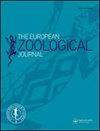药物阉割对圈养红鹿和休耕鹿内分泌和化学特性的影响
IF 1.4
4区 生物学
Q2 ZOOLOGY
引用次数: 0
摘要
摘要在野生动物圈养管理中,由于近亲繁殖的风险和需要控制种内和种间的入侵,避孕是非常可取的。鹿,手术阉割会导致鹿角的异常生长,是合适的药物阉割的候选人。本研究的目的是评价药理学阉割对两种鹿的生理模式和挥发性化学成分的影响。在意大利托斯卡纳野生动物救援中心,我们将醋酸德斯洛林(4.7毫克)皮下植入四只雄性马鹿(Cervus elaphus)和两只雄性黇鹿(Dama Dama) (N = 6),它们生活在一个混合性别和物种的群体中。我们结合了激素测量和跖嗅觉腺气味分泌物的化学研究,以测试药物阉割是否会影响挥发性化学特征,从而可能改变发情季节的嗅觉交流。我们使用放射免疫分析技术测定粪便和血浆睾酮以及粪便皮质醇水平,并使用固相微萃取和气相色谱-质谱联用分析嗅觉腺气味分泌物。我们发现植入物皮下沉积后,鹿的睾酮水平下降。然而,在整个研究期间,阉割的马鹿在睾酮浓度方面表现出更多的变化,而在植入后,后者的睾酮水平仍然很低。我们在雄性嗅觉腺分泌物中检测到124种(马鹿)和88种(黇鹿)挥发性化合物,包括天然存在的酮类、醇类、醛类、萜烯类、羧酸类、酯类、挥发性脂肪酸和碳氢化合物。马鹿的气味丰富度,而不是化合物的总丰度或比例,随着睾丸激素水平的变化而变化。综上所述,我们的初步研究结果表明,醋酸地氯瑞林可以降低雄性激素水平,影响气味分泌物的化学特征,在人类管理的鹿种群中可以作为一种非侵入性避孕方法。本文章由计算机程序翻译,如有差异,请以英文原文为准。
Effects of pharmacological castration on endocrinological and chemical profiles in captive red and fallow deer
Abstract In wildlife captive management, contraception is highly desirable due to inbreeding risk and needed control of intra- and inter-specific aggressions. Deer, for which surgical castration can cause abnormal growth of the antlers, are suitable candidates for pharmacological castration. The aim of this study was to evaluate the effect of pharmacological castration on the physiological patterns and volatile chemical profiles of two deer species. We placed a subcutaneous implant of deslorelin acetate (4.7 mg) on four male red deer (Cervus elaphus) and two male fallow deer (Dama dama) (N = 6) living together in a mixed-sex and -species group housed at a wildlife rescue centre in Tuscany, Italy. We combined hormone measurements and chemical investigation of metatarsal scent-gland odour secretions to test whether pharmacological castration will influence the volatile chemical profile, potentially modifying the olfactory communication during the rutting season. We used radioimmunoassay technique to determine faecal and plasma testosterone as well as faecal cortisol levels, and solid-phase microextraction coupled to gas chromatography-mass spectrometry to analyse the scent-gland odour secretions. We found that deer testosterone levels decreased after the subcutaneous deposition of the implant. However, castrated red deer exhibited more variability in testosterone concentrations throughout the study period compared to fallow deer, whose testosterone levels remained low after the implant. We detected a total of 124 (red deer) and 88 (fallow deer) volatile compounds in male scent-gland odour secretions, including naturally occurring ketones, alcohols, aldehydes, terpenes, carboxylic acids, esters, volatile fatty acids, and hydrocarbons. Odour richness, but not total abundance or ratios of compounds, changed with testosterone levels in red deer. In conclusion, our preliminary findings suggest that deslorelin acetate, causing a decrease of testosterone level and impacting the chemical profile of odour secretions, could work as a non-invasive contraception approach in human-managed populations of deer.
求助全文
通过发布文献求助,成功后即可免费获取论文全文。
去求助
来源期刊

European Zoological Journal
Agricultural and Biological Sciences-Animal Science and Zoology
CiteScore
3.10
自引率
5.60%
发文量
80
审稿时长
30 weeks
期刊介绍:
The European Zoological Journal (previously Italian Journal of Zoology) is an open access journal devoted to the study of all aspects of basic, comparative and applied protozoan and animal biology at molecular, cellular, tissue, organ, organismal, population, and community-ecosystem level. Papers covering multiple levels of organization and integrative approaches to study animal form, function, development, ecology, evolution and systematics are welcome. First established in 1930 under the name of Il Bollettino di Zoologia, the journal now has an international focus, reflected through its global editorial board, and wide author and readership.
 求助内容:
求助内容: 应助结果提醒方式:
应助结果提醒方式:


